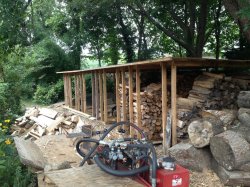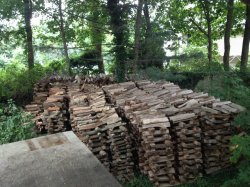Over the last couple of years, it seems most of the time when folks are trying to calculate how much wood they have...they go by a dimensional formula...You know,,LxWxH.....What about using a weight formula instead> All of us know a Cord of Red Oak is a lot better that a Cord of Silver Maple....But why? Same dimensions right....The reason is because of the weight. The chart below should help....
CORDWOOD WEIGHT CONVERSION FACTORS
Weight conversion factors are generally established by the various mills and are accepted for billing purposes. The following weight conversion factors may be used as guidelines in the conversion of weight scale to standard 128 cubic foot cord.
Weights shown are for average cordwood size wood that is reasonably straight. Consequently, wood conditions which may increase or decrease the amount of solid wood in a cord must be taken into consideration when applying these data.
Up to a 5% reduction is often warranted for wood that is unusually small, or wood that is usually crooked.
Up to a 5% increase is often warranted if sawlog size material was cut for pulp, or the material is exceptionally straight.
Seasoned wood is normally understood to be that which was cut and dried two or more months between April 1 and October 31 before weighing. All other wood should be considered green.
Factors for mixed cordwood may be developed by weighted average of cruise estimates based on species volume distribution and/or ocular estimate.
CORDWOOD WEIGHT CONVERSION FACTORS - POUNDS PER CORD
Species Green Seasoned
Hemlock 4800 4650
Tamarack 4650 4450
Red Pine 4500 4350
Jack Pine 4250 4100
Balsam 4250 4050
White Pine 4200 4000
Spruce 4000 3850
Cedar 3150 3050
White Oak 5850 5650
Red Oak 5500 5350
Hickory 5400 5200
Yellow Birch5350 5150
Hard Maple 5100 4900
Beech 5050 4850
Elm 5000 4800
Balsam Poplar 4900 4650
White Birch 4800 4600
Cottonwood 4650 4400
Ash 4600 4450
Soft Maple 4550 4350
Aspen4500 4300
Basswood3850 3650
CORDWOOD WEIGHT CONVERSION FACTORS
Weight conversion factors are generally established by the various mills and are accepted for billing purposes. The following weight conversion factors may be used as guidelines in the conversion of weight scale to standard 128 cubic foot cord.
Weights shown are for average cordwood size wood that is reasonably straight. Consequently, wood conditions which may increase or decrease the amount of solid wood in a cord must be taken into consideration when applying these data.
Up to a 5% reduction is often warranted for wood that is unusually small, or wood that is usually crooked.
Up to a 5% increase is often warranted if sawlog size material was cut for pulp, or the material is exceptionally straight.
Seasoned wood is normally understood to be that which was cut and dried two or more months between April 1 and October 31 before weighing. All other wood should be considered green.
Factors for mixed cordwood may be developed by weighted average of cruise estimates based on species volume distribution and/or ocular estimate.
CORDWOOD WEIGHT CONVERSION FACTORS - POUNDS PER CORD
Species Green Seasoned
Hemlock 4800 4650
Tamarack 4650 4450
Red Pine 4500 4350
Jack Pine 4250 4100
Balsam 4250 4050
White Pine 4200 4000
Spruce 4000 3850
Cedar 3150 3050
White Oak 5850 5650
Red Oak 5500 5350
Hickory 5400 5200
Yellow Birch5350 5150
Hard Maple 5100 4900
Beech 5050 4850
Elm 5000 4800
Balsam Poplar 4900 4650
White Birch 4800 4600
Cottonwood 4650 4400
Ash 4600 4450
Soft Maple 4550 4350
Aspen4500 4300
Basswood3850 3650




